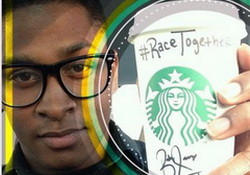
Starbucks has launched a new campaign called #RaceTogether, designed to encourage coffee drinkers and baristas to “have a conversation about race.” It’s like a game, created with very good intentions. To play, your Starbucks barista may write #RaceTogether on a random customer’s cup. The selected customer is then encouraged to start a conversation or make a comment about racism or race. Newscat says, remember, if you can’t say anything nice – don’t hesitate to forfeit your turn…No one wears hot coffee well.
If you fear that it might be awkward to start a conversation about such sensitive issues, you’re in luck. Comedian Rob King, in his role as “Senior Vice President of Barista Strategies” is here to help. King offers Starbucks baristas and the “mostly affluent customers” they serve, some tips to help broach the topic with intelligence and grace. What you really need are some fun conversation starters, Rob advises something like this: “Welcome to Starbucks, would you like to talk about race?”
Be creative, and speak to the individual: “I see you’re wearing a Confederate flag T-Shirt, would you like to discuss inequality?”
Here’s a thought-provoking comment. Rob reminds us “white is a color too, people forget that.”
Wasn’t that easy and fun? Now, rather than dreading receiving a marked cup, you’ll be the customer with your hand in the air,screaming ‘choose me, please!’
Remember,”at Starbucks, we respect your heritage AND your order.”
The program is the brainchild of Starbucks CEO Howard Schultz, who hopes to foster productive discussions about race and racism. While Schultz has the best of intentions, the program is catching a lot of criticism for encouraging a discussion on race without providing any guidelines or educational material. The louder protests undoubtedly come from the anonymous quarter who have chosen to vent their bigotry in Starbuck’s direction.
.
Schultz will persevere, because as he says “the program is not designed to point fingers, and not because we have answers, but because staying silent is not who we are.”